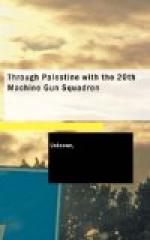Reaching the southern outskirts of the town, they entered it by the road leading past the prison up to the Clock Tower. Leaving this on the right, they turned sharply to the left (past the present Officers’ Club) almost up to Divisional Headquarters (then already established), where they bore to the right, down to the bridge under the railway, at the French railway station. The bridge had been blown up and a truck which was hanging down, completely blocked the roadway, causing considerable delay, as the whole Brigade had to lead their horses in “single file” up the steep embankment, across the railway lines, and down the other side, in order to regain the road. Two and a half miles along the Alexandretta Road the Brigade turned to the left off the road, east of Bileramum, and halted for the night, it being then 23.45.
The next morning, at 05.30, the 14th Brigade took over the outpost-line from the 15th Brigade. The Deccan Horse and “No. 3” Section held the ground west of the road. The Poona Horse and “No. 1” Section held the road itself and east of it. An enemy rearguard patrol was seen retiring, and was followed up by Sherifian troops, but nothing more was seen of the Turk. During the morning the 13th Brigade took over the ground to the west of the road, thus relieving the Deccan Horse and “No. 3” Section. “No. 2” Section relieved “No. 1” Section.
At night, “No. 1” Section with “S.R.Y.” and “No. 3” with Deccan Horse took over the line. Members of the Squadron who took part in the operations from Khan Tuman onwards, will remember that “No. 2” and “No. 3” Sections, owing to shortage of personnel due to sickness (principally malaria or dysentery), had only been able to man three guns each, instead of their full complement of four, so that when “No. 2” Section was on duty “No. 3” Section supplied a detachment to make them complete, “No. 2” doing the same when “No. 3” was on duty, whilst in order to have all the guns in the Squadron available in case of emergency, the Squadron headquarter troops manned the remaining two guns. The next two days (October 28th and 29th) the outpost-line was still held, and nothing in the way of active operations occurred; men not on duty were granted passes to visit Aleppo.
ARMISTICE WITH TURKEY.
On the morning of October 30th, our Brigade was relieved by the “13th,” and moved eastwards across the railway, then northward to MUSLIMIE JUNCTION. No enemy being encountered, an outpost line was established about two miles north, “No. 1” Section with “S.R.Y.” and “No. 2” (with one detachment of “No. 3”) with the Poona Horse. The latter section was entirely alone during the day, as it was not considered necessary to have so many troops on duty as at night time, and the Squadron being too far away to allow of the Section doing the double journey with any degree of comfort, it remained where it was.
At 12.00 on October 31st an armistice with Turkey was proclaimed, the good news being communicated to the Sections on outpost duty by orderlies from Headquarters. The Sections, however, had orders to remain at their posts. November 4th brought the further news of an armistice with Austria, and early the following day Indian prisoners, released by the Turks, began to return to us through our outpost line.




